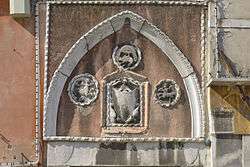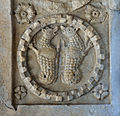Patera (architecture)
In architecture, patera (pl. paterae) is an ornamental circular or oval bas-relief disc.[1][2] The patera is usually used to decorate friezes and walls, and to interrupt moldings.[3] Patera is also used in furniture-making. It can be carved, incised, inlaid, or even painted.[4][5]

Overview
The patera is found in the ancient Roman architecture and in almost all later western styles of architecture.[6] The patera is used both within the civil and church architecture is usually made of marble or Istrian stone. It has a variable diameter between 20 and 80 cm, while the thickness is around 10 cm. The subject represented in the bas-relief is generally of floral or animal type, but there are also figures symbolizing trades or people.[7] Being mainly a decorative element, the patera may also perform an apotropaic function to keep away evil spirits.
Gallery
 Patera in the Corte seconda del Milion court and the romanesque archway Sotoportego del Teatro in Venice.
Patera in the Corte seconda del Milion court and the romanesque archway Sotoportego del Teatro in Venice.- Detail of the church Santa Margherita in Venice.
 Lunette above the entrance to the Fondaco dei Turchi reconstructed in neobyzantine stile by Federico Berchet AD 1869 in Venice.
Lunette above the entrance to the Fondaco dei Turchi reconstructed in neobyzantine stile by Federico Berchet AD 1869 in Venice. Entrance to the Carmini church in Venice.
Entrance to the Carmini church in Venice. Volto Santo on the Strada Nuova in Cannaregio Venice.
Volto Santo on the Strada Nuova in Cannaregio Venice.
References
- "Fragment of Roman frieze(?) enrichment: a patera with a floral centre". CollectionsOnline. Retrieved 3 September 2019.
- Saylor, Henry H. (1994). Dictionary of Architecture. John Wiley & Sons. p. 128. ISBN 9780471756019. Retrieved 3 September 2019.
- Parker, John Henry (1845). A Glossary of Terms Used in Grecian, Roman, Italian, and Gothic Architecture. J.H. Parker. p. 274. Retrieved 3 September 2019.
patera architecture.
- Furniture, Mackinnon Fine (6 August 2019). "The ABCs of Decorative Arts: Patera". The Source. Retrieved 3 September 2019.
- "Patera and Paterae". Lynn Byrne. Retrieved 3 September 2019.
- "Patera". Buffalo as an Architectural Museum. buffaloah.com. Retrieved 3 September 2019.
- Scott, Ann Reynolds (2008). Cosa: The Black-glaze Pottery 2. University of Michigan Press. p. 62. ISBN 9780472115853. Retrieved 3 September 2019.